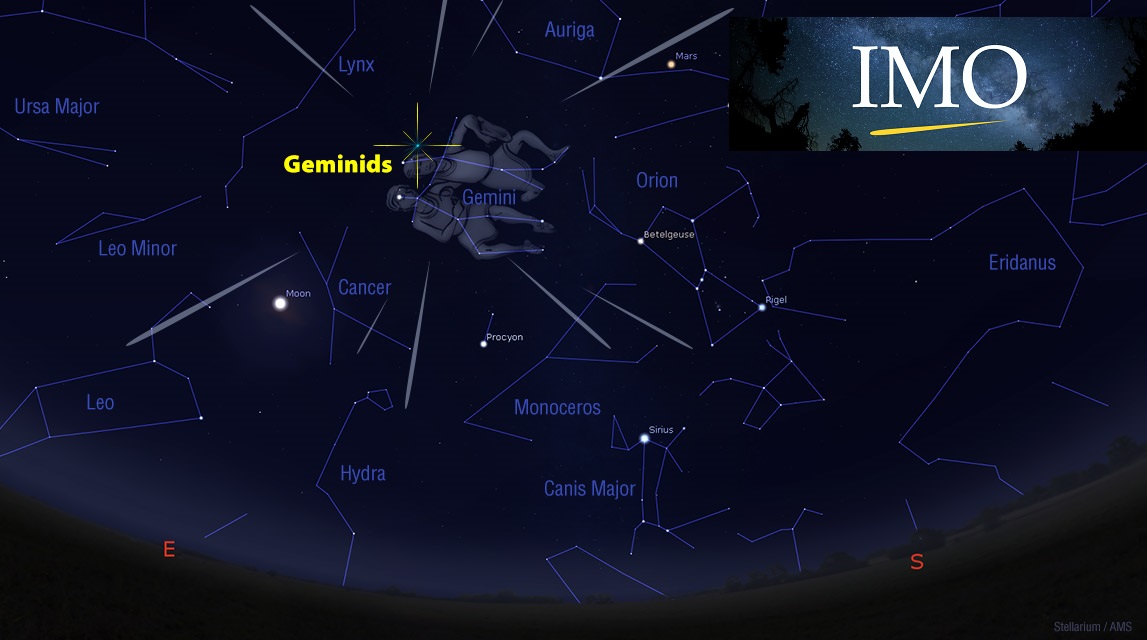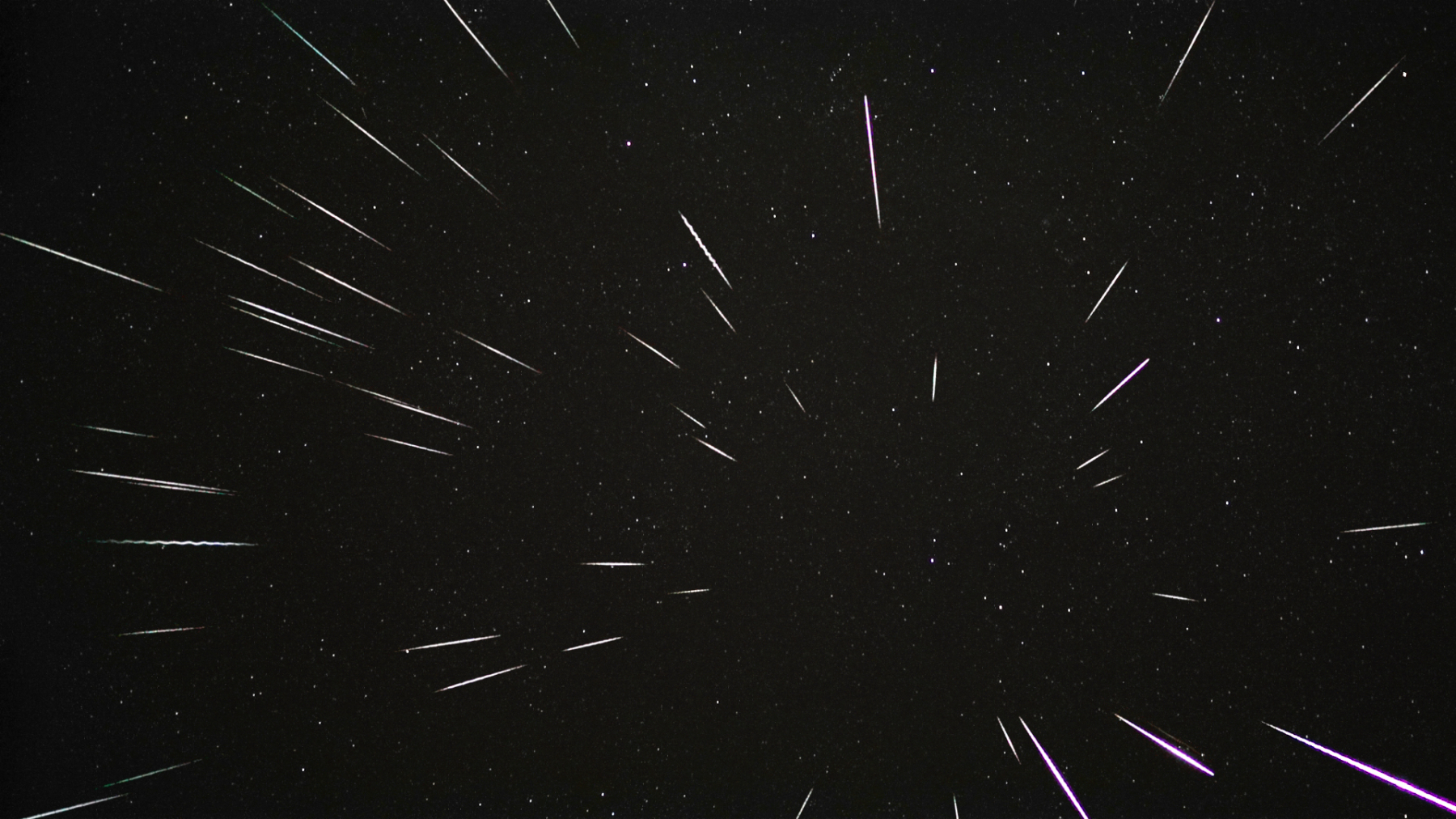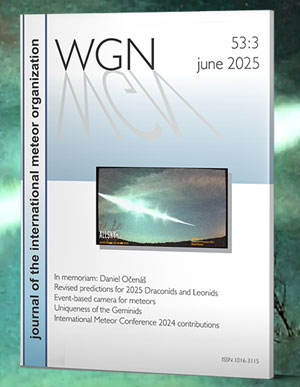
The Geminids are active from November 24 through December 24, but don’t kick into high gear until the second week of December. The moon reaches its last quarter phase on December 4th and viewing conditions improve with each passing night as the moon’s phase wanes toward new. Maximum activity is predicted to occur on the night of December 13/14. Hourly rates of 10 can be seen as early as December 6th, but the waning crescent moon may reduce that a bit. By December 10th hourly rates should reach 25 with little lunar interference. By December 12th the moon has reached its new phase and hourly rates should reach 50 as seen from dark sky sites with a limiting magnitude of at least +6.5. Rates are expected to be near 60 on the night of the 12/13 and peak near 80 on the 13/14. The fall from maximum is much more rapid than its climb. Rates on the 14/15 are expected to still be near 60 but will have fallen to less than 20 per hour on the night of 15/16. I highly suggest you take advantage of any clear nights in this period as these rates are some of the highest of the year and shouldn’t be wasted.
Near maximum the Geminid radiant is located near the bright star Castor (alpha Geminorum) and is easy to locate (See the illustration above). All Geminid meteors will trace back to this area of the sky. If you observe prior to the maximum the radiant will be approximately one-degree further west for each night prior to the 14th. Near maximum a great majority of all the meteors seen will be Geminids. Reports with 100% Geminid meteors are difficult to believe though as sporadic activity is still strong this time of year plus minor showers from Hydra, Monoceros, and Leo Minor should contribute meteors too.

The Geminids are one of the few meteors showers that are visible all night long, at least as seen from the northern hemisphere. During the early evening hours, the radiant lies low in the eastern sky and Geminid meteors are often long and long-lasting. Rates are low at this time as the horizon blocks a sizable percentage of the Geminid meteors striking the atmosphere. As the night progresses activity will increase as the radiant gains altitude. The radiant lies highest in the sky between the hours of 1:00 and 2:00 local standard time. These are the prime hours to view Geminid activity, but the two hours prior and post maximum can be impressive too! No matter what time it is, Geminid meteors can be seen in any part of the sky. Most of the activity will actually be seen in the lower portion of the sky so when you are observing, look half-way up with the bottom of your field of view just above the horizon. Don’t let trees or other obstructions block your view. Look a little bit higher if necessary or just change your direction. It also helps to look toward the darkest direction possible to help you see faint meteors. Most articles advise you to look 90 degrees from the radiant where the shower meteors are longest. Personally, I don’t like changing directions during a viewing session, especially when the weather is cool. Therefore, I aim my view so that the radiant drifts through my field of view during the midpoint of the session. With the radiant high overhead like the Geminids, the radiant actually skims the top portion of my field of view and not the central area. This also allows me to also keep tabs on the minor showers active in Monoceros, Hydra, and Leo Minor during my watch.
Don’t go outside and stand to try and view the Geminid activity. Your neck will quickly stiffen and you will soon tire. I suggest using a comfortable lounge chair that allows you to view the sky comfortably. Bring a pillow and plenty of blankets to keep warm. Those who wish to contribute meteor counts should watch for at least one hour. The reason for this is that meteoroids are distributed randomly in outer space. When quoted hourly rates are 60, this does not mean you will see one meteor every minute. There will be 5 to 10 minute periods when little activity is evident. There will also be periods of similar length when there will be continuous activity of 3-4 meteors per minute. There are several “peaks” and “valleys” of meteor activity each hour so if you only watch for a short time, you may find yourself viewing during one of the lulls of activity.
Geminid meteors strike the Earth’s atmosphere from a perpendicular angle, therefore their velocity is of a medium speed. Unlike the super-fast Leonids, the Geminids tend to last from one-half up to one full second. The fastest Geminids will be seen 90 degrees from the radiant and high in the sky. Those that appear close to the radiant will appear slower and shorter as they are shooting toward you. This slower velocity does not often produce persistent trains, so this feature is rare for Geminids. The longer lasting Geminids provide good opportunities for meteor photography. As stated before, the highest number of meteors will appear in the lower portion of the sky above the horizon. In that portion of the sky, you are looking through the thickest slice of atmosphere, which is not good for looking through a telescope, but great for meteor watching and photography. Have you ever noticed that a majority of fireball photos are centered low in the sky? This is the reason why.
Viewing meteor activity is a great way to easily contribute to science by being a citizen scientist. In order to produce scientifically useful data you need to view for at least one hour and provide shower associations with each meteor you witness. It also is necessary to provide us with cloud conditions and the magnitude of the faintest star you can see. The limiting magnitude is easily done by counting the number of stars visible with certain areas of the sky – see also https://www.imo.net/observations/methods/visual-observation/ and here for more tips on viewing meteor showers. In order to share your observations it is suggest that you to fill out a visual meteor report form from the International Meteor Organization. This is only available to registered members, but this option is free to those who just wish to contribute data. We strongly encourage everyone to join the IMO as a full member as detailed analysis of the Geminids and others meteors showers are presented in the IMO Journal.
We wish you good luck and look forward to seeing your viewing results!
This illustration of debris from 3200 Phaethon orbiting the sun is provided by Dr. Peter Jenniskens, SETI Institute/NASA/Ames Research Center. Use your mouse to change the angle of the illustration and your mouse wheel to zoom in and out.




 You saw something bright and fast? Like a huge shooting star? Report it: it may be a fireball.
You saw something bright and fast? Like a huge shooting star? Report it: it may be a fireball.  You counted meteors last night? Share your results with us!
You counted meteors last night? Share your results with us!  You took a photo of a meteor or fireball? You have a screenshot of your cam? Share it with us!
You took a photo of a meteor or fireball? You have a screenshot of your cam? Share it with us!  You caught a meteor or fireball on video? Share your video with us!
You caught a meteor or fireball on video? Share your video with us!